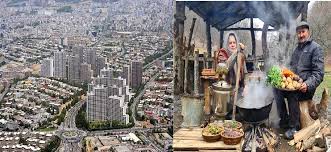Comparison of urban and rural life
There are significant differences between urban and rural life in Afghanistan. Each of these areas faces its own challenges and advantages that have shaped the living conditions for residents differently.
- Access to public services
Urban areas: In big cities such as Kabul, Herat and Mazar-e-Sharif, access to public services such as education, health and transportation is better than in rural areas. However, the quality of these services is still low, and due to the large population, it is challenging to provide adequate services for everyone.
Rural areas: In rural and remote areas, access to public services, especially health and education, is very limited. People in these areas have to travel to big cities to access basic medical and educational services, which requires a lot of time and money.
- Educational facilities
Urban areas: Cities have access to more schools, universities and educational institutions, although there are restrictions, especially for girls. The quality of education in cities is also not suitable due to lack of resources, but it is still better than rural areas.
Rural areas: Many villages are deprived of even basic educational facilities and most children drop out of school. The lack of teachers and infrastructure in villages has caused families to face great challenges in educating their children.
- Sanitary facilities
Urban areas: cities have more health centers and hospitals, although the capacity and quality of their services are still limited and far from global standards. In times of emergency, people in cities have better access to doctors and medicines.
Rural areas: Health services are very limited in rural areas and many villagers have to travel to cities to receive treatment. The lack of specialist doctors and medicine in these areas has made health conditions more difficult for the villagers.
- Economy and job opportunities
Urban areas: There are more job opportunities in cities, but many people work in informal, low-income jobs. Unemployment is still a serious challenge in cities and many people are in economic trouble due to not having a suitable job.
Rural areas: Villagers are mainly engaged in agriculture and animal husbandry. These jobs are highly dependent on weather conditions and natural resources and are considered unstable in terms of income. The lack of various job opportunities in the villages has caused many young people to migrate to the cities in the hope of finding work.
Rural life in Afghanistan has its own characteristics and unlike urban life, it often brings simplicity and closeness to nature. But due to the lack of basic facilities and sufficient services, life in villages faces many challenges. In the following, we will examine various aspects of rural life in Afghanistan:
Village life
-
Economy and livelihood
The economy of Afghan villages is mainly based on agriculture and animal husbandry. Many villagers cultivate crops such as wheat, barley, and local fruits for their livelihood, and some also raise livestock such as cattle, sheep, and goats. However, these activities are highly dependent on weather conditions, and drought and climate change can easily affect villagers’ lives. The lack of modern agricultural equipment and limited access to large markets also make it difficult for villagers to generate income. -
Access to health services
Many villages lack proper health centers and hospitals, and access to medical services is severely limited. The lack of specialist doctors, lack of medicine and medical equipment has made health conditions more difficult for the villagers. People living in remote areas often have to travel to cities for treatment, which takes a lot of money and time. -
Education and training
In rural areas, educational facilities are extremely limited. Many villages lack adequate schools and students have to travel long distances to get to school. In addition, the lack of teachers and educational infrastructure has caused the quality of education to be low. Many children, especially girls, are deprived of access to education and this prevents the development of the next generation. -
Lack of infrastructure
Basic infrastructure is missing or very weak in many villages of Afghanistan. Rough and dirt roads, lack of proper transportation system and lack of access to electricity are among the main infrastructural problems in rural areas. Many villages do not even have access to safe drinking water and people have to use unsafe water sources. -
Status of women
Women in rural Afghanistan face many restrictions and often have heavy responsibilities, including doing housework, farming, and raising livestock. In addition, their access to education and health services is more limited and they have fewer economic and social opportunities for advancement. Traditional beliefs and customs have also caused more restrictions in the lives of rural women. -
Lifestyle and social culture
Rural life in Afghanistan is often intertwined with local culture and customs. Village people live close together and social solidarity is strong among them. Helping and supporting each other in daily work and in times of problems is one of the distinctive features of rural life. This lifestyle is based on traditional and family-oriented values, and village people have a close relationship with nature. -
Impact of climate change and environmental problems
Villagers are heavily affected by climate change and environmental problems. Successive droughts, reduction of water resources, and soil erosion are among the problems that directly affect agriculture and animal husbandry, which are the main sources of income for villagers. These conditions have made life more difficult for people and have increased migration from the village to the city.
conclusion
Despite the simplicity and proximity to nature, life in the villages of Afghanistan is accompanied by many challenges due to the lack of facilities, services, and infrastructure. Problems such as lack of access to education, health, and proper markets have endangered the future of the villagers. These challenges show that in order to improve living conditions in villages, the need for sustainable development programs and investment in infrastructure and public services is felt.
